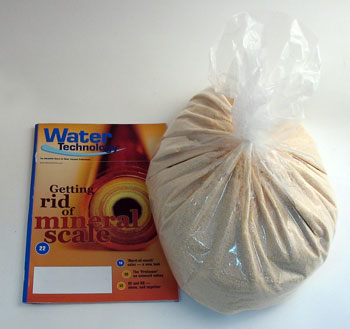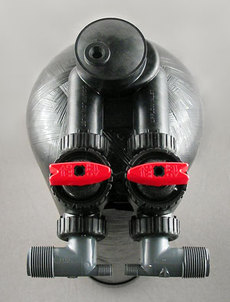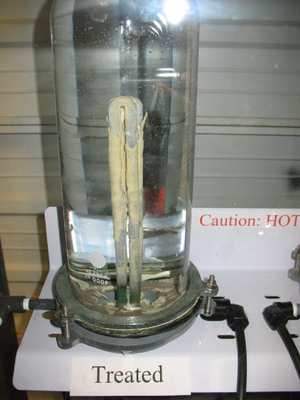Special Mid-Month Issue December 15, 2011 Read This Issue on the Occasional's Website |
|---|
Template Assisted Crystallization
by Gene Franks
There are several new water conditioning systems on the market designed to deal with the age-old problem of scale formation in pipes and appliances without the disadvantages (salt usage, environmental degradation, etc.) associated with the conventional water softener.
Many earlier alternative "softening" systems relied on magnets and a variety of electrical devices to send waves and pulses through pipes in an attempt to rearrange the molecular structure of the water's hardness (calcium & magnesium) ions.
The newest in alternative softening devices work differently. Like the conventional water softener, they use a treatment medium contained in a standard mineral tank. Water is passed through the granular medium inside the tank and treated.
Unlike the softener, however, they do not need to be regenerated with salt and they do not need to connected to a drain. They require no sophisticated electronic control system. They are, therefore, much easier to install and set up. No maintenance, electricity, or salt is needed.
The new media-style softener alternatives use treatment media sold under a variety of brand names. Filtersorb, Next, ScaleNet, and Pelican, for example.
They have in common that they do not remove calcium and magnesium ions from water (as softeners do) but, rather, they change these hardness minerals from their ionic form to a harmless crystalline form. In this very stable form, calcium and magnesium do not attach to pipes, appliances, and fixture surfaces. The crystals are so small, in fact, that they are readily rinsed away by the normal flow of water. This technology is often referred to as "template assisted crystallization," or simply TAC.
If you want to get a little more technical, Chubb Michaud explains TAC as follows: "TAC employs a special surface-treated resin bead to act as a catalytic nucleation site for the conversion and growth of hardness crystals, which are subsequently released and remain in solution without forming scale." Another writes says, similarly, "Atomic sized nucleation sites on the surface of small ceramic-polymer beads convert dissolved hardness into microscopic crystals. Once the crystals grow to a certain size they are released from the bead. The crystals in solution keep the hardness out of the water so that it can't form scale or interfere with soap." Another writer says, "Unique 'Template Assisted Crystallization' (TAC) technology induces the formation of microscopic calcium crystals which effectively isolate hardness from the water chemistry."
However the process is explained, TAC application has gained wide acceptance in a short time even in an industry bent on fostering and protecting its cash cow, the conventional water softener.
 |
|---|
| Much Power in a Tiny Package. The bag of ScaleNet medium above weighs less than 10 pounds, but it's all that's needed for a 10" X 54" treatment tank. ScaleNet is so light it can be shipped pre-loaded in the treatment tank. |
The descaling units featured on our website are designed, tested, and built by Watts using ScaleNet™ conditioning anti-scale medium, the superior Vortech gravel-free mineral tank, and Clack accessory parts.
The delivery system used with ScaleNet is much simpler than that of conventional water softeners. Although only a small amount of ScaleNet is needed, it is used in a full-sized mineral tank--the same tank used for softeners and large filters--to assure adequate contact time.
Unlike softeners, ScaleNet units have no connection to drain and no electrical connection is needed. No regeneration of the medium is required.
 |
|---|
| Standard Watts ScaleNet unit seen from above. Water goes in one side and out the other. No drain connection is required. The non-electric head is the durable Clack head that we use on our best In/Out filters. The red-handled device is an optional bypass. |
Here are some things to consider about ScaleNet.
ScaleNet needs less contact time than softener resin, so smaller treatment tanks can be use per service flow.
No salt, chemicals or other regenerants are required.
No backwashing, so no connection to drain or water use.
Commercial grade ScaleNet units are made by simply adding more of the treatment medium to the contact tank.
No brine discharge. (ScaleNet units can be used in areas where conventional water softeners are banned or regulated.)
Granular ScaleNet has a long lifespan--usually about 5 years on residential applications.
Life expectancy of the unit itself (exclusive of the medium) is many, many years. The mineral tank is guaranteed for 10 years, and the unit has no moving parts.
Cartridge applications are available for treatment for specific applications (like protecting instant hot water heaters).
An important difference between ScaleNet and softeners is that ScaleNet actually removes existing scale from pipes and appliances. Softeners prevent new scaling, but do not remove existing scale buildup.
ScaleNet does not remove chlorine but it is somewhat chlorine tolerant. The medium will last longer if city water users install a carbon filter in front of it to remove chlorine.
Unlike softeners. Scalenet units do not add sodium to water.
Maximum hardness treated by standard residential system is 25 grains. Commercial units are available for harder water or extended service runs, or residential systems can be oversized to compensate for added hardness.
Scalenet units require no cleaning or chemical conditioning agents.
ScaleNet requires essentially clean influent water. Iron, manganese and excessive sediment (if any) should be treated ahead of the unit. Water softeners remove iron, but ScaleNet units must be protected from iron.
Residential ScaleNet units are sized for standard stop/start residential use. For extended service flow such as long irrigation runs or filling a swimming pool, the unit should be bypassed or a commercial unit should be used.
 |
|---|
In January of 2008, Watts Water Conditioning performed a series of tests on ScaleNet's ability to prevent scale formation on hot water heater elements. (See picture above.)
The result was impressive. Not only did ScaleNet prevent formation of new scale deposits, it actually removed existing scale.
Pictures of the entire experiment can be viewed on our main website.
A look at residential ScaleNet units with details and pricing information is available on our main website. We have commercial units, but they are not yet listed on our website. Please call for information.
A concise fact chart comparing ScaleNet units with conventional softeners.
A Watts brochure with ScaleNet model listings.
The Pure Water Occasional is a project of Pure Water Products. Please visit our websites: Main Website: www.purewaterproducts.com. This site features our full range of products, plus instructions, technical articles, product manuals, and more. The Occasional's Website: www.purewateroccasional.net. In addition to archiving back issues of the email Occasional, this site houses a sizeable section about water contaminants, a "how things work," series, a new products section, a glossary of water treatment terms, and, "much, much more." Other Pure Water Products Sites: www.purauv.com To contact us by phone, please call 940 382 3814.
|
|---|